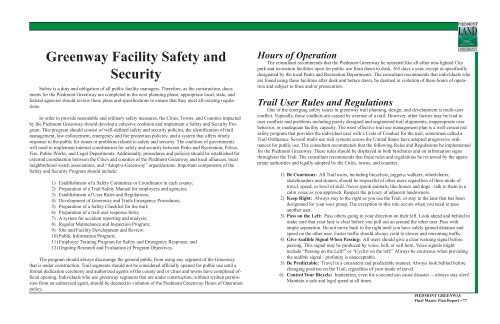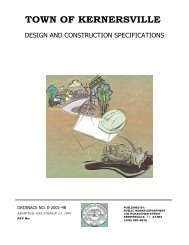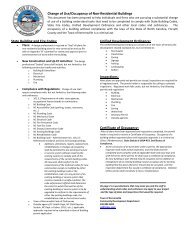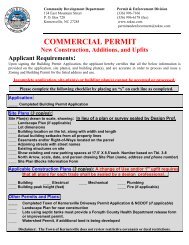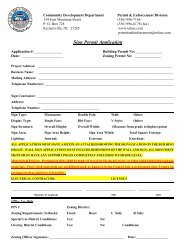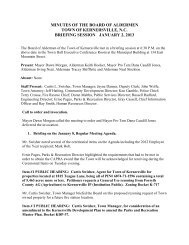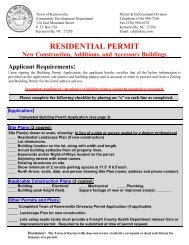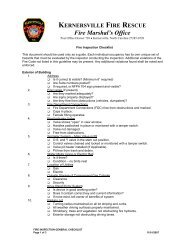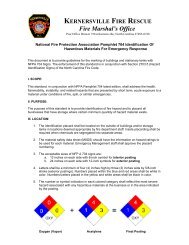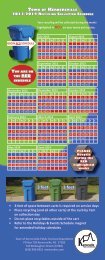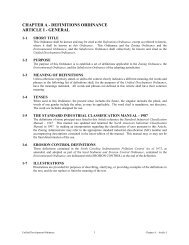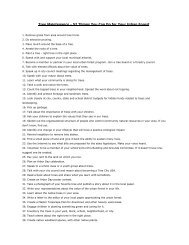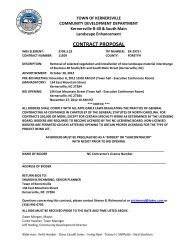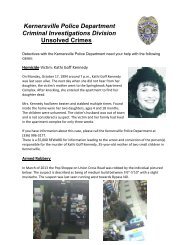Piedmont Greenway Master Plan - Town of Kernersville
Piedmont Greenway Master Plan - Town of Kernersville
Piedmont Greenway Master Plan - Town of Kernersville
- No tags were found...
Create successful ePaper yourself
Turn your PDF publications into a flip-book with our unique Google optimized e-Paper software.
<strong>Greenway</strong> Facility Safety and<br />
Security<br />
Safety is a duty and obligation <strong>of</strong> all public facility managers. Therefore, as the construction, documents<br />
for the <strong>Piedmont</strong> <strong>Greenway</strong> are completed in the next planning phase, appropriate local, state, and<br />
federal agencies should review these plans and specifications to ensure that they meet all existing regulations.<br />
In order to provide reasonable and ordinary safety measures, the Cities, <strong>Town</strong>s, and Counties impacted<br />
by the <strong>Piedmont</strong> <strong>Greenway</strong> should develop a cohesive coalition and implement a Safety and Security Program.<br />
This program should consist <strong>of</strong> well-defined safety and security policies; the identification <strong>of</strong> trail<br />
management, law enforcement, emergency and fire protection policies; and a system that <strong>of</strong>fers timely<br />
response to the public for issues or problems related to safety and security. The coalition <strong>of</strong> governments<br />
will need to implement internal coordination for safety and security between Parks and Recreation, Police,<br />
Fire, Public Works, and Legal Departments. Additionally, procedures and policies should be established for<br />
external coordination between the Cities and counties <strong>of</strong> the <strong>Piedmont</strong> <strong>Greenway</strong> and local alliances, local<br />
neighborhood watch associations, and “Adopt-a-<strong>Greenway</strong>” organizations. Important components <strong>of</strong> the<br />
Safety and Security Program should include:<br />
1) Establishment <strong>of</strong> a Safety Committee or Coordinator in each county;<br />
2) Preparation <strong>of</strong> a Trail Safety Manual for employees and agencies;<br />
3) Establishment <strong>of</strong> User Rules and Regulations;<br />
4) Development <strong>of</strong> <strong>Greenway</strong> and Trails Emergency Procedures;<br />
5) Preparation <strong>of</strong> a Safety Checklist for the trail;<br />
6) Preparation <strong>of</strong> a trail user response form;<br />
7) A system for accident reporting and analysis;<br />
8) Regular Maintenance and Inspection Program;<br />
9) Site and Facility Development and Review;<br />
10) Public Information Program;<br />
11) Employee Training Program for Safety and Emergency Response; and<br />
12) Ongoing Research and Evaluation <strong>of</strong> Program Objectives.<br />
The program should always discourage the general public from using any segment <strong>of</strong> the <strong>Greenway</strong><br />
that is under construction. Trail segments should not be considered <strong>of</strong>ficially opened for public use until a<br />
formal dedication ceremony and authorized agents <strong>of</strong> the county and or cities and towns have completed <strong>of</strong>ficial<br />
opening. Individuals who use greenway segments that are under construction, without written permission<br />
from an authorized agent, should be deemed in violation <strong>of</strong> the <strong>Piedmont</strong> <strong>Greenway</strong> Hours <strong>of</strong> Operation<br />
policy.<br />
Hours <strong>of</strong> Operation<br />
The consultant recommends that the <strong>Piedmont</strong> <strong>Greenway</strong> be operated like all other non-lighted City<br />
park and recreation facilities open for public use from dawn to dusk, 365 days a year, except as specifically<br />
designated by the local Parks and Recreation Departments. The consultant recommends that individuals who<br />
are found using these facilities after dusk and before dawn, be deemed in violation <strong>of</strong> these hours <strong>of</strong> operation<br />
and subject to fines and/or prosecution.<br />
Trail User Rules and Regulations<br />
One <strong>of</strong> the emerging safety issues in greenway trail planning, design, and development is multi-user<br />
conflict. Typically, these conflicts are caused by overuse <strong>of</strong> a trail. However, other factors may be lead to<br />
user conflicts and problems including poorly designed and engineered trail alignments, inappropriate user<br />
behavior, or inadequate facility capacity. The most effective trail use management plan is a well-conceived<br />
safety program that provides the individual user with a Code <strong>of</strong> Conduct for the trail, sometimes called a<br />
Trail Ordinance. Several multi-use trail systems across the United States have adopted progressive ordinances<br />
for public use. The consultant recommends that the following Rules and Regulations be implemented<br />
for the <strong>Piedmont</strong> <strong>Greenway</strong>. These rules should be displayed in both brochures and on information signs<br />
throughout the Trail. The consultant recommends that these rules and regulations be reviewed by the appropriate<br />
authorities and legally adopted by the Cities, towns, and counties.<br />
1) Be Courteous: All Trail users, including bicyclists, joggers, walkers, wheelchairs,<br />
skateboarders and skaters, should be respectful <strong>of</strong> other users regardless <strong>of</strong> their mode <strong>of</strong><br />
travel, speed, or level <strong>of</strong> skill. Never spook animals; like horses and dogs - talk to them in a<br />
calm voice as you approach. Respect the privacy <strong>of</strong> adjacent landowners.<br />
2) Keep Right: Always stay to the right as you use the Trail, or stay in the lane that has been<br />
designated for your user group. The exception to this rule occurs when you need to pass<br />
another user.<br />
3) Pass on the Left: Pass others going in your direction on their left. Look ahead and behind to<br />
make sure that your lane is clear before you pull out an around the other user. Pass with<br />
ample separation. Do not move back to the right until you have safely gained distance and<br />
speed on the other user. Faster traffic should always yield to slower and oncoming traffic.<br />
4) Give Audible Signal When Passing: All users should give a clear warning signal before<br />
passing. This signal may be produced by voice, bell, or s<strong>of</strong>t horn. Voice signals might<br />
include “Passing on the Left!” or “Cyclist on the left!” Always be courteous when providing<br />
the audible signal - pr<strong>of</strong>anity is unacceptable.<br />
5) Be Predictable: Travel in a consistent and predictable manner. Always look behind before<br />
changing position on the Trail, regardless <strong>of</strong> your mode <strong>of</strong> travel.<br />
6) Control Your Bicycle: Inattention, even for a second can cause disaster —always stay alert!<br />
Maintain a safe and legal speed at all times.<br />
PIEDMONT GREENWAY<br />
Final <strong>Master</strong> <strong>Plan</strong> Report • 77


